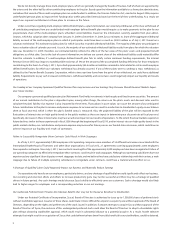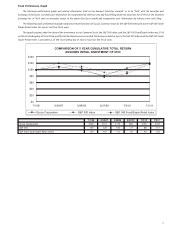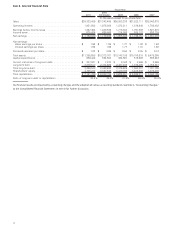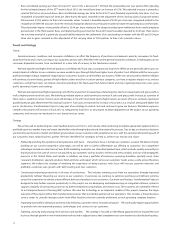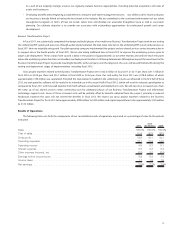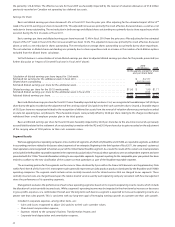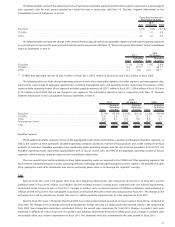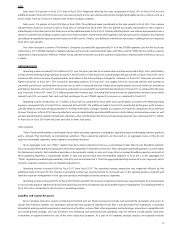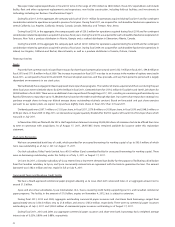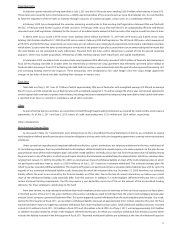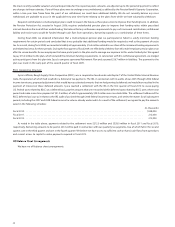Sysco 2011 Annual Report Download - page 42
Download and view the complete annual report
Please find page 42 of the 2011 Sysco annual report below. You can navigate through the pages in the report by either clicking on the pages listed below, or by using the keyword search tool below to find specific information within the annual report.impact of these operating expense increases was partially offset by a decrease in operating expenses of approximately $99.8 million resulting
from the absence of the 53rd week in fiscal 2011.
Operating expenses for fiscal 2010 were lower than in fiscal 2009 primarily due to reduced fuel costs and a favorable comparison on the
amounts recorded to adjust the carrying value of COLI policies to their cash surrender values in both periods. Partially offsetting these operating
expense declines were increases in pay-related expenses, net company-sponsored pension costs and approximately $99.8 million of expense
associated with the additional week included in fiscal 2010.
Pay-related expenses, excluding labor costs associated with our Business Transformation Project, increased by $62.8 million in fiscal 2011 over
fiscal 2010. The increase was primarily due to increased sales and gross profit, which resulted in increased delivery personnel costs and sales
compensation. Portions of our pay-related expense are variable in nature and are expected to increase when sales and gross profit increase. Pay-
related expenses from acquired companies and changes in the exchange rates used to translate our foreign sales into U.S. dollars also contributed
to the increase. Partially offsetting these increases were lower provisions for current management incentive bonuses of $12.1 million.
Pay-related expenses, excluding labor costs associated with our Business Transformation Project, increased by $43.9 million in fiscal 2010 over
fiscal 2009. The fiscal 2010 increase was primarily due to increased provisions for management incentive accruals and cost associated with the
additional week included in fiscal 2010. Partially offsetting these increases were lower pay-related expenses due to reduced headcount. The
criteria for paying annual bonuses to our corporate officers and certain portions of operating company management bonuses are tied to overall
company performance. In fiscal 2010, the overall company performance criteria for payment of such bonuses was met; therefore, the provision for
current management incentive bonuses was higher in fiscal 2010 than in fiscal 2009 when the company assessed it did not meet the criteria for
paying certain annual bonuses. Headcount declines occurred in fiscal 2010 due to both productivity improvements and workforce reductions
commensurate with lower sales. Headcount was 2.2% lower at the end of fiscal 2010 as compared to fiscal 2009.
Net company-sponsored pension costs in fiscal 2011 were $60.3 million higher than in fiscal 2010. The increase in fiscal 2011 was due
primarily to a decrease in discount rates used to calculate our projected benefit obligation and related pension expense at the end of fiscal 2010,
partially offset by reduced amortization of our net actuarial loss resulting from actuarial gains from higher returns on assets of Sysco’s Retirement
Plan during fiscal 2010. Net company-sponsored pension costs in fiscal 2012 have been determined as of the fiscal 2011 year-end measurement
date and will decrease by approximately $27 million from fiscal 2011 due primarily to higher returns on assets of Sysco’s Retirement Plan during
fiscal 2011.
Net company-sponsored pension costs were $37.4 million higher in fiscal 2010 than in fiscal 2009. The increase in fiscal 2010 was due
primarily to lower returns on assets of Sysco’s company-sponsored qualified pension plan (Retirement Plan) during fiscal 2009, partially offset by
an increase in the discount rates used to calculate our projected benefit obligation and related pension expense for fiscal 2010.
From time to time, we may voluntarily withdraw from multi-employer pension plans to minimize or limit our future exposure to these plans.
We recorded provisions related to multi-employer pension plans of $41.5 million in fiscal 2011, $2.9 million in fiscal 2010 and $9.6 million in fiscal
2009. See additional discussion of multi-employer pension plans at “Liquidity and Capital Resources, Other Considerations, Multi-Employer
Pension Plans.”
Sysco’s fuel costs increased by $33.0 million in fiscal 2011 over fiscal 2010 primarily due to increased contracted and market diesel prices. Our
fuel costs decreased by $71.8 million in fiscal 2010 over fiscal 2009 primarily due to decreased contracted diesel prices. Sysco’s costs per gallon
increased 14.3% in fiscal 2011 over fiscal 2010, as compared to a decrease of 26.1% in fiscal 2010 over fiscal 2009. Sysco’s activities to mitigate fuel
costs include reducing miles driven by our trucks through improved routing techniques, improving fleet utilization by adjusting idling time and
maximum speeds and using fuel surcharges. We routinely enter into forward purchase commitments for a portion of our projected monthly diesel
fuel requirements with a goal of mitigating a portion of the volatility in fuel prices.
Our fuel commitments will result in either additional fuel costs or avoided fuel costs based on the comparison of the prices on the fixed price
contracts and market prices for the respective periods. In fiscal 2011, the forward purchase commitments resulted in an estimated $16.4 million of
avoided fuel costs as the fixed price contracts were generally lower than market prices for the contracted volumes. In fiscal 2010, the forward
purchase commitments resulted in an estimated $1.5 million of additional fuel costs as the fixed price contracts were higher than market prices for
the contracted volumes for a portion of the fiscal year. In fiscal 2009, the forward purchase commitments resulted in an estimated $67.7 million of
additional fuel costs as the fixed price contracts were higher than market prices for the contracted volumes.
As of July 2, 2011, we had forward diesel fuel commitments totaling approximately $86 million through June 2012. These contracts will lock in
the price of approximately 30% to 35% of our fuel purchase needs for the contracted periods at prices lower than the current market price for
diesel for the first 26 weeks of fiscal 2012 and near the current market price for diesel for the remainder of the fiscal year. Subsequent to July 2,
2011, we entered into forward diesel fuel commitments totaling approximately $17 million for July and August 2012. Assuming that fuel prices do
not rise significantly over recent levels during fiscal 2012, fuel costs exclusive of any amounts recovered through fuel surcharges, are expected to
increase by approximately $35 million to $45 million as compared to fiscal 2011. Our estimate is based upon current, published quarterly market
price projections for diesel, the cost committed to in our forward fuel purchase agreements currently in place for fiscal 2012 and estimates of fuel
consumption. Actual fuel costs could vary from our estimates if any of these assumptions change, in particular if future fuel prices vary significantly
from our current estimates. We continue to evaluate all opportunities to offset potential increases in fuel expense, including the use of fuel
surcharges and overall expense management. Based on our current projections, we anticipate that the increase in fuel surcharges will offset the
majority of our projected fuel cost increase in fiscal 2012 as compared to fiscal 2011.
18


